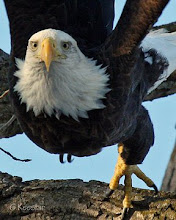

This is the Norfolk Nest at the Botanical Gardens.
THIS PAIR HAS TOTALLY BUILT A NEW NEST

While our pairs are busy returning to their nesting areas I wanted to take a little closer look at that nest that some like Norfolk have built from scratch just this year, and all of the other nest we watch online are doing the refurbishing. Then of course there is Kent with that huge hole George the squirrel has made. Our eagle pairs are getting busy. Take a look at what the are doing.
Info on Eagles nests taken from Bald Eagle Journey North
Airy Aeries
Of all birds in the world, Bald Eagles hold the record for the biggest nest ever built. One nest in Florida was 6.1 meters deep, 2.9 meters wide, and weighed 2,722 kg (almost 3 tons).
When a young pair of Bald Eagles needs to build a brand new nest, their first job is to find a place for it. They probably prefer a territory close to water, where they can catch fish for their babies without wasting time flying back and forth a long distance, but in some areas may nest several miles from fishing areas.
In parts of Alaska and northern Canada where trees are scarce and short, eagles often nest on the ground. In forested areas, they usually select one of the tallest trees in the area. If this is a "super-canopy" tree (one sticking up above nearby trees) the eagles can see all around, and also can fly into the nest without bonking their huge wings into branches.
In Canada and the northern and western states, eagles almost always select a coniferous tree-usually a pine, spruce, or fir. In the eastern states, where large conifers may not be available in otherwise good habitat, eagles are more likely to nest in an oak, hickory, cottonwood, or other large leafy tree.
Where do eagles get the sticks for their nest? They pick up broken sticks from the ground, and sometimes break branches off trees. They naturally take as many sticks as they can find close to the nest, but may lug some branches as far as a mile, carrying them in their talons
Eagles, along with several other hawks, add sprigs of greenery to their nests throughout the spring and summer. No one knows why they do this, but scientists have some ideas.
may serve as an insect repellent may be a clear signal to other eagles that this nest is well-tended so they better keep away may provide a bit of camouflage may help keep inside of nest clean
Home Again, Home Again! (and The Work Begins!)
Eagles usually don't lay eggs until several weeks after arriving at the nest site. They spend the first days dealing with their neighbors
In addition to defending the area from intruders, both males and females help to build the nest. If it's not their first year on the nest, they just add to the same nest used in previous years. The branches used can be up to 6 feet long and 2 inches thick.The one common denominator just about all eagle nests have in common, is the view: the view from a eagles nest is one of the most spectacular on earth - they certainly know how to pick the prime lookout spots.
 |


4 comments:
Oh my goodness!! Look at all the action I have been missing! These videos have made my day....
GOOD SHOW, GLO!
Do you know if the Norfolk nest has been rebuilt in the same tree? It looks very similar, but since it's from a different angle, it's hard to be sure.
Jim
No Jim thi is a totally new nest. Info from the Norfolk Botannical site says
"The eagle family’s move means that camera and wireless Internet gear must also be moved. Joe Foreman of Norfolk Botanical Garden said that workers will soon be relocating equipment to another tree near the new nest. "
And if you enjoyed this cam las tyear...take a look at this added info...
McElveen said the Eagle Cam will be back online as soon as the camera can be relocated to see the new nest. He added that several enhancements to the online display are planned for the 2008 nesting season, including increased bandwidth on the video stream to give a sharper more fluid image.
Very good and informative answer to my question regarding Norfolk, Glo. Thank you very much.
Jim
Post a Comment